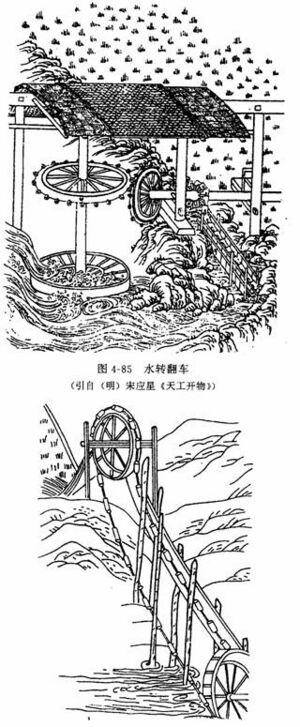Chain pump facts for kids
A chain pump is a special kind of water pump. It uses a long, endless chain with many circular discs on it. One part of the chain goes down into the water. The chain then moves up through a tube that is a little wider than the discs. As the chain moves up, the discs trap water and lift it to the top. The water then flows out. Chain pumps have been used for thousands of years in places like the ancient Middle East, Europe, and China.
Chain Pumps in the West
The first signs of chain pumps come from a text in Babylonia around 700 B.C. People or animals usually powered these early pumps. Later, around 200 B.C., similar devices appeared in ancient Egypt.
Ancient Greeks and Romans also used chain pumps. Sometimes, they attached pots or scoops to the chain. As these passed over the top wheel, they would tip the water out. A chain pump from the 2nd century is still kept in London. Philo of Byzantium wrote about such a pump in the 2nd century B.C. The historian Vitruvius also mentioned them around 30 B.C. Parts of a chain pump, like gears and discs, were found from a Roman boat in Lake Nemi. This shows they were used as bilge pumps on ships.
During the Renaissance, chain pumps were important in European mines. Georg Agricola, who studied minerals, showed them in his famous book De re metallica in 1556. They were also used in shipyards, like the Portsmouth Block Mills. Many navy ships used chain pumps to remove water from their lower parts, called bilges. Even in the 1800s, they helped with irrigation to lift water for farms.
Chain Pumps in China
Chain pumps were also used in ancient China starting from at least the 1st century A.D. In China, they were often called dragon backbones. One of the first descriptions came from the philosopher Wang Chong around A.D. 80. Chinese chain pumps often had square paddles instead of round discs. These pumps would lift water up a slanted channel.
Some Chinese chain pumps were powered by the force of flowing water turning a water wheel. Others were pulled by oxen. There were also chain pumps that people operated by using pedals with their feet.
From the 1st century onwards, chain pumps became very common in the Chinese countryside. They were mostly used for irrigation to water crops. But they also helped with public works. For example, the engineer Bi Lan built many chain pumps outside the capital city Luoyang. These pumps brought water to the palaces and homes through a system of pipes. Ma Jun, a famous engineer from the Three Kingdoms era, also built chain pumps to water the royal gardens of Emperor Ming of Wei.
During the agricultural expansion in Song China (from the 10th to 13th centuries), water-lifting tools got even better. The simple 'well-sweep' was common. But the 'square-pallet chain pump' became much more popular for farming around the end of the first millennium A.D.
Later, from the 13th century, the Chinese also started using windmills to power their square-pallet chain pumps. There were other types too. In Song Yingxing's book Tiangong Kaiwu (1637), he showed a chain pump that used waterwheels to lift water from a river to higher farm fields.
Poets like Li Chuquan praised how chain pumps helped farming grow during the Song Dynasty. The Song government actively shared this technology. They introduced pumping tools and chain pumps to areas that didn't know about them yet.
See also
- Airlift pump
- Chain drive
- Rope pump
- Sakia
- Waterladder pump


